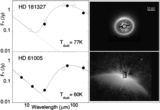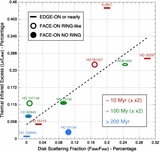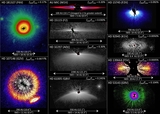Image Details

Caption: Figure 23.
HD 61005 six-roll combined PSFTSC imaging (north up, east left) from all WedgeA-0.6 and WedgeA-1.0 observations. Log10 display stretches A–D from [−1], [−2], [−3], [−4] to [+1.5] dex (all panels) counts s−1 pixel−1 (~18, 1.8, 0.18, 0.018 to 5600 mJy arcsec−2). Field: 400 × 250 STIS pixels (20![]() 28 × 10
28 × 10![]() 14)—north up, east left. Red circle r = 0
14)—north up, east left. Red circle r = 0![]() 3 (six STIS pixels = width of WedgeA-0.6). The morphology, geometry, and "front-to-back" SB asymmetry of a now well-seen highly inclined debris ring (previously identified in ground-based LOCI and ADI imaging by REFS) is suggested by the illustration to scale in panel (A). The nearly symmetric observed "ridges" of diffuse scattering grains, morphologically bifurcated in the skirt of lower-SB material to the SE of the star are indicated (compare also to HD 11515, panel (E)).
3 (six STIS pixels = width of WedgeA-0.6). The morphology, geometry, and "front-to-back" SB asymmetry of a now well-seen highly inclined debris ring (previously identified in ground-based LOCI and ADI imaging by REFS) is suggested by the illustration to scale in panel (A). The nearly symmetric observed "ridges" of diffuse scattering grains, morphologically bifurcated in the skirt of lower-SB material to the SE of the star are indicated (compare also to HD 11515, panel (E)).
Copyright and Terms & Conditions
© 2014. The American Astronomical Society. All rights reserved.












